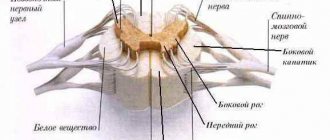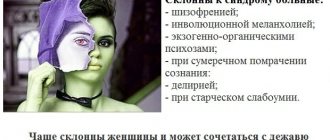Psychological protection
Definition 1
Psychological defense is a system of mental processes that are aimed at minimizing internal discomfort and anxiety caused by external and internal conflicts, and at preserving the “I” as a subjective world for adequate interaction with reality.
The term "defense" (chosen by Sigmund Freud) reflects 2 aspects of thinking:
- Freud sought to make his ideas acceptable to a skeptical public, he used analogies, compared psychological actions with army maneuvers, compromises in solving strategic problems.
- When confronted with dramatic examples, the psychoanalyst saw the protective functions of the psyche. He was attracted to people who had emotional disturbances, in which hysterical traits predominated, and who were trying to prevent a repetition of previous experiences.
Defense mechanisms have many beneficial functions, they emerge as healthy adaptations and continue to function throughout life. If their action is aimed at protecting the “I” from any threats, then they are considered as direct “defense”. An individual's behavior may be defensive in that he or she unconsciously strives to accomplish one (or both) of the following tasks:
Finished works on a similar topic
- Course work Psychological protection in behavior 430 rub.
- Abstract Psychological protection in behavior 270 rub.
- Test: Psychological protection in behavior 220 rub.
Receive completed work or specialist advice on your educational project Find out the cost
- Master anxiety or other emotional experiences.
- Maintain composure.
Each person prefers certain defenses, which become part of his individual style of dealing with difficulties and troubles. This use of certain protection is the result of a complex interaction of 4 factors:
- Innate temperament.
- Stress experienced in early childhood.
- Defense mechanisms passed on from parents.
- Experience the consequences of using individual protection mechanisms.
Types of protective mechanisms and their properties
Each person has his own way of responding to environmental influences, in accordance with his individual characteristics and existing psychological characteristics of the individual. In this regard, there are several types of protective mechanisms:
- projection;
- crowding out;
- substitution;
- rationalization;
- identification;
- reactive formation;
- sublimation;
- negation;
- regression.
Finished works on a similar topic
- Course work Types of protective mechanisms 460 rub.
- Abstract Types of protective mechanisms 230 rub.
- Test work Types of protective mechanisms 240 rub.
Receive completed work or specialist advice on your educational project Find out the cost
Protective psychological mechanisms by their nature have a number of properties:
- act as self-deception, due to the fact that they find their manifestation on an unconscious level;
- often distort adequate perception of the real world;
- represent the emotional side of the reaction to surrounding events;
- arise on the basis of fear of the transition of negative impulses into a conscious process.
Defense Mechanisms
Currently, more than 20 types of protection mechanisms are known. They are divided into primitive and secondary types of protection.
Primary defense mechanisms include those mechanisms that interact with one’s own “I” and the outside world. It has insufficient connection with the principle of reality and consideration of the separateness and permanence of objects located outside the “I”. Primitive defenses are the ways in which a child experiences the world.
Secondary defenses are more developed and mature; more often they work with internal boundaries - between the experiencing and observing parts of the “I”.
Too lazy to read?
Ask a question to the experts and get an answer within 15 minutes!
Ask a Question
There are 8 main defense mechanisms that regulate 8 basic emotions. Some of the mechanisms stand out as unambiguous, others constitute a combination of several protection options that are similar in content. Next, let's look at the basic protection mechanisms in more detail:
Negation. This defense mechanism involves refusing existing troubles; it is the earliest way to cope with them. A person automatically responds to any trouble with a denial; the subconscious is controlled by conviction; if he does not admit it, then it did not happen. For a person whose main defense is denial, it is considered normal to insist that everything is good, everything is for the better, everything will transform. The ability to deny danger in emergency circumstances can be life-saving on an emotional level, so a person can take the most effective actions. Denial can lead to the opposite outcome, for example, an elderly person denies that his ability to drive a car has weakened, instead of refusing to drive, etc.
Projection. This defense mechanism involves attributing to another person thoughts, feelings and motives that are not characteristic of him. It serves basic empathy. No one can penetrate someone else's psyche; in order to understand the subjective world of another person, we must project our own experience. In large quantities, projection causes misunderstanding and damage to interpersonal relationships. Some may resent being misperceived; if they are imputed, for example, with envy, they may retaliate in kind.
Substitution (displacement). A defense mechanism redirects emotions or behavior from a natural object to another because its original direction is alarmingly hidden for some reason. For example, a man was scolded at work by his superiors; when he came home, he took his anger out on his wife, who, in turn, scolded the children, who beat the cat or dog. This is how substitution works.
Repression (repression, suppression). The defense is one of the first to attract the attention of the psychoanalyst Freud. The point is that a person deliberately forgets or ignores something. Something is removed from consciousness or kept at a certain distance from it. The mechanism applies to everything related to experience, fantasies and desires.
Intellectualization. The mechanism acts with a higher level of isolation of affect from intellect. An intellectualist talks about feelings in such a way that the listener may not understand the real emotions. This defense mechanism usually keeps the normal overwhelm or presence of emotions at bay.
Reactive education. Defense involves transforming negative affect into positive and vice versa. The human body is capable of turning something in the opposite direction and minimizing the threat. For example, the transformation of hatred into love, affection into contempt, etc.
Compensation. The mechanism manifests itself in attempts to find a replacement for a real shortcoming or defect with another quality through fantasizing or assigning to oneself the qualities, properties, and advantages of another person. This happens when it is necessary to avoid conflict with a specific person in order to increase self-sufficiency.
Regression. The mechanism refers to simple defenses that are familiar to every parent who has observed how their child shows his emotions when hungry, tired or sleepy. This process is unconscious, for example, people react to the stress caused by age-related changes in such a way that they get sick.
PROTECTIVE MECHANISMS OF PERSONALITY
PROTECTIVE MECHANISMS OF PERSONALITY, forms of the unconscious mental. activities aimed at eliminating psychological discomfort, unpleasant experiences that arise when self-esteem or personal integrity is threatened. Z. m. l. distort disturbing aspects of reality, eliminate them from consciousness or reduce the severity of their experience, allowing a person to preserve ideas about himself, the people around him and the world that are important for his positive and consistent identity.
Z. Freud came up with the idea of “protecting the Self” through repression (forgetting disturbing experiences). The concept of "Z. m.l." was described in the work of A. Freud “Psychology of the Self and Defense Mechanisms” (1936, Russian translation, 1993), where they are presented as adaptive strategies for relieving internal and external conflicts, used already in early childhood. V. Reich described various types of character that are formed depending on which Z. m. l. people prefer to use, and compared the so-called with them. muscular armor - chronic. muscle tensions characteristic of this or that Z. m. l. A. Freud identified 10 specific Z. m.l., other researchers - up to 20–30 Z. m.l. (often appearing together); It is often noted that any mental the process can be used as a Z. m. l. Nevertheless, there are a number of the most common Z. m. l. Denial is ignoring the source of anxiety, refusing to acknowledge its significance, or interpreting negative experiences as positive. Projection is the attribution to other people of one’s own desires, ideas, experiences and character traits that are not recognized by oneself, or the reasons for one’s own experiences (for example, a person, feeling fear, may consider others dangerous or hostile). Introjection (identification) – the assimilation of other people’s (primarily parental) feelings, attitudes, beliefs, patterns of behavior (for example, identification with a dangerous or threatening individual creates the illusion of one’s own strength). Regression is a return to primitive, childish forms of behavior, emotions and thinking. Rationalization (or moralization) is the justification of one’s desires by rational (or moral) necessity. Sublimation is the transformation of unacceptable desires and emotions into constructive, creative, socially approved forms of activity. Isolation (autistic fantasizing) – withdrawal into fantasies or altered states of consciousness. Displacement is the transfer of emotions to another object (for example, a person who has received a reprimand at work behaves aggressively with his spouse). Idealization is the belief in the special virtues of loved ones, in the fact that they are able to provide protection from all dangers. Undoing is atonement, the ritual of “undoing” an action for which a person feels guilty, by the opposite action or self-punishment. Perceptual defense is the transformation of an unpleasant object in the process of its perception.
As useful adaptive ways to reduce emotional tension Z. m. l. are used by every person, but can create problems associated with withdrawal from reality and a passive position, making it impossible to eliminate the causes of conflicts. The concept of "Z. m.l." widely used in psychoanalysis. diagnostics, gestalt therapy and other areas of psychotherapy; Often the therapist seeks to help the client become aware of their preferred personality defense mechanisms.
Definition of the concept of “defense mechanism”
Definition 1
The term “defense mechanism” is understood as a psychological process whose purpose is to reduce anxiety, worries, and tension so that a person can be in balance with himself and the people around him.
This process is unconscious. This concept first appeared in the works of the famous Austrian psychologist, psychotherapist and psychiatrist S. Freud in 1894, in one of his works devoted to the origin of neuropsychoses.
As a result of the interaction of the individual and social elements, a conflict between the individual and external circumstances may arise. This conflict manifests itself in the form of tension, anxiety, and restlessness. In such situations, in order to cope with this conflict and keep the person’s psyche in a normal state, a protective psychological mechanism is activated. Classification of psychological defense mechanisms of the individual. To date, there is no unified classification of psychological defense mechanisms of the individual. But basically, defense mechanisms are divided into two main groups:
Finished works on a similar topic
- Course work Protective mechanism: compensation 450 rubles.
- Abstract Protective mechanism: compensation 240 rubles.
- Test work Protective mechanism: compensation 240 rubles.
Receive completed work or specialist advice on your educational project Find out the cost
- Projective;
- Definitive.
The purpose of projective defense mechanisms is to convey the necessary information to a person’s consciousness. This group usually includes projection, denial, identification, etc. Definitive mechanisms, in turn, try to distort information. This group includes sublimation, rationalization, regression, etc.
There are a wide variety of types of psychological defense mechanisms, these include:
- sublimation;
- negation;
- crowding out;
- substitution;
- rationalization;
- projection;
- somatization;
- reactive formation;
- regression;
- intellectualization;
- insulation;
- fixation;
- compensation;
- response.








